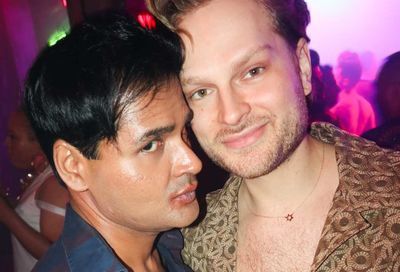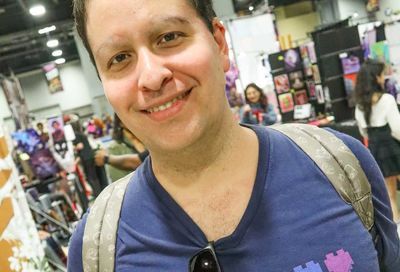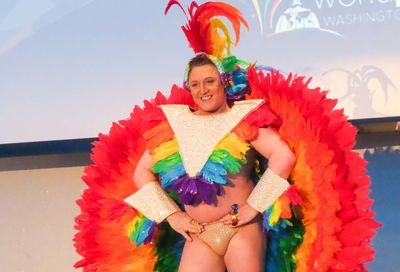Gallery: Blake Little’s Breathtaking ‘Construction Nudes’
In "Construction Nudes 1981-1985," renowned photographer Blake Little surveys the beauty of anatomy and architecture.

Stealth is often required in the creation of stunning art — and it’s absolutely necessary when that art involves trespassing in broad daylight on building construction sites around Los Angeles, with models, lights, and camera equipment in tow.
“Everything that I did with the buildings and bringing the models there was super-planned,” Blake Little tells Metro Weekly about capturing the breathtaking images in his new monograph Construction Nudes 1981-1985.
“I would usually shoot on Sundays because there’s nobody there,” the photographer continues. “And I would scout on Saturdays after the people would leave. So then I would know how to get in, where I was going, to try to make it as efficient and not get caught. But also, I think now, there’s way more cameras, there’s way more security, and it would be harder to do.”
Then, it was 1981, cameras weren’t everywhere, including inside every person’s pocket. Seattle native Little had just arrived in L.A., having studied science for three years at the University of Seattle, before realizing he “didn’t know why” he was studying science. He had also realized he was gay.
“So part of coming out made me switch from science to communications, and then dropping out of the university and going to photo school,” he says. After completing his photography degree at Seattle Central College, and briefly giving San Francisco a try, he landed in the City of Angels, which was also, in its way, coming out.
“So when I moved to L.A., there was a lot of building going on, in preparation for the Olympics,” he recalls. “I’d always been interested in architecture, and I kept seeing all these new buildings and the structure of these new buildings. In addition to that, I’ve always been attracted to brutalist materials like concrete, steel, rebar, dirt.”

Initially, Little started scouting sites intending to photograph the buildings themselves. “But when I got inside and discovered these tableaus, which were almost like little created scenes, I thought, ‘Okay, I have to bring models here.'”
Many of those models, posed nude amongst the raw, industrial materials, were friends of Little’s, or from within the same LGBTQ community — a community that already was being transformed by the HIV/AIDS crisis as he continued to capture the era in images.
“After the first year, I lost my first friend, Kris Johnson, to AIDS,” he says. “That affected the work and the posing of the models and the whole series. You see it particularly in the pictures of couples in the book. But a lot of it was subconscious, when I look back now. I never really set out to make a statement or make an image to be, ‘Oh, that’s going to be about loss and death.’ It just comes out in the work.”
Loss also reverberates in the lived history of the models who didn’t get to see these photos exhibited or published. The images, from Little’s first project after he moved to L.A., sat in his archives for 40 years. During the process of rediscovering the photos with his editor, Frank Rodriguez, Little hoped to reconnect with his muses.
But, as he offers sadly, “I cannot find Andre. So I have to assume he passed away. And then Brian, he passed away in ’97. Armando, I can’t find Armando, assume he passed away as well. Steve, who’s on the cover, he’s alive and well. I just had an opening here in Palm Springs at the Jaco Moretti Gallery, and we did an artist talk, and Steve came and talked about his experience, so that was really cool.”
Little, now based in Palm Springs — with countless awards, honors, and prestigious exhibitions to his credit, and seven previous monographs, including The Company of Men and Blake Little: Photographs from the Gay Rodeo — continues to capture images of his community in his current series Golden Years.
“I spend most of my time now in [the] Palm Springs area, so being here and being around the community, it’s a really special place for the older gay community,” he says.
“People come out here to live their identities and their life to the fullest. That’s what Golden Years is about: these really colorful people taking their identity and their being and their life, living it out to the fullest. People think, ‘Oh, you’re retired, you stop being sexual, you stop being vibrant,’ and I find that that’s not the truth for most people here. It’s really a refreshing community.”
Construction Nudes 1981-1985 and other Blake Little books and monographs can be found at https://blakelittle.store/books-by-blake-little-construction-nudes/.
To see more from Blake Little’s “Construction Nudes,” keep scrolling.








Support Metro Weekly’s Journalism
These are challenging times for news organizations. And yet it’s crucial we stay active and provide vital resources and information to both our local readers and the world. So won’t you please take a moment and consider supporting Metro Weekly with a membership? For as little as $5 a month, you can help ensure Metro Weekly magazine and MetroWeekly.com remain free, viable resources as we provide the best, most diverse, culturally-resonant LGBTQ coverage in both the D.C. region and around the world. Memberships come with exclusive perks and discounts, your own personal digital delivery of each week’s magazine (and an archive), access to our Member's Lounge when it launches this fall, and exclusive members-only items like Metro Weekly Membership Mugs and Tote Bags! Check out all our membership levels here and please join us today!






















You must be logged in to post a comment.